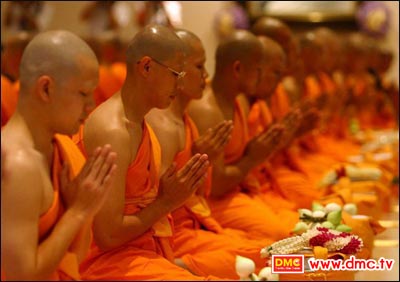The Sight of a True Monk#1
Happiness arising from sensual pleasures or worldly pleasures
The children need a good role model from parents and teachers.
The householders also need a good role model from the true monk
The importance of “the sight of a true monk”
There are two kinds of happiness that can be found in this world
1. Happiness arising from sensual pleasures or worldly pleasures
In an outward happiness. For example: seeing beautiful artwork, listening to good music, smelling of the fragrance, eating good food, touching of the softness etc. It is an external happiness that can be easily attained.
2. Happiness arising from the inside through meditation practice
Can be attained through meditation to gain the inner peace and the inner wisdom. It is the inner happiness of the one who attains the Dhamma within. The inner happiness arising from the inner peace is the true happiness and superb than any other happiness, but yet difficult for one to attain and to comprehend.
Happiness that arises internally is beyond one presumption. It is a personal experience. Only those who practice the Dhamma and meditation can experience this true happiness. Those who do not practice the Dhamma will not be able to understand the feelings of happiness by just reading from the book.
As the monk once said, “A person who observes the precepts will have a clear and delightful mind”. For those who never practice Dhamma would suddenly disagree with the above statement because they believe that teople who practice the Dhamma must be continuously aware of what they are doing and try not to violate the precepts. Unlike people who have not observed the precepts, they could drink alcohol; go out at night, gamble or having a party which they consider to be much more fun than those who are practicing the Dhamma.
When someone meets a person who obtained the inner happiness or a person that observes the precepts properly who is having graceful and cheerful appearance, is not in an angry mood, always speaking beautifully, then he may start to believe that it is true that the person who had obtained the inner happiness looks different from other people that he had known before. Even though he does not yet believe in this fact he might wish to follow though he does not yet believe in this fact he might wish to follow the practice of those who attained the inner happiness. He might still hesitate to practice but at least he will get the urge to do some good deeds
A true monk is the one who has attained the inner peace. Anybody who gets a chance to see him will have an inspiration to practice the Dhamma teaching. It is like an ignited bomb that fully shows its explosive power. One can demonstrate all the wisdom, knowledge and expertise to perform wholesome deeds at full right after seeing the true monk.
Happiness arising from the inside through meditation practice
Definition of “Samana” (The True Monk)
“Samana” means “peaceful one” and referred to “Pabbajita”, an ascetic who fully cultivates “Samanadhamma”, duties of monastic observances which includes (Sila) to keep the precepts, (Samathi) to concentrate on meditation and (Panna) to reflect on the Lord Buddha’s teaching to gain inner wisdom. Their body, speech and mind are at peace and abstain from any demeritorious deeds. Every “Samana” must be an ascetic, but some of the ascetics are not qualified as “Samana” (a true monk).
“One cannot be a true monk only because he is ordained. A monk who ignores the monastic observances should not be considered as a true monk.
The person who I, “Tathagata” , shall call him as a true monk must be the one who abstains from all means of demeritorious actions.”
Description of a true monk
1. A true monk must be peaceful in action:
He must be careful, not be impetuous and free from any provocative actions such as not carry weapons, pick fights with others, walk in a demonstration, competing for fame/popularity or competing in earning a living. These are the actions of the person who does not have inner peace. The true monk will be graceful and charismatic in his presence and never cause any harm to others in any situation.
The Lord Buddha praised venerable Moggallana that even though ven.Moggallana has supernormal power, but in any of his presence never caused any harm to the others. Even when he went on an alms round he would accept an appropriate portion that would not cause any harm to the person who offers the food. Like a bee that only drinks the pollen but never hurts the flower.
In addition, a Samana also has to act appropriately for the purity of the monk hood.
A true monk must be peaceful in action
2. A true monk must be peaceful in speech:
He must be completely free from malicious gossip, slander or boasting. For example, mudslinging among monastic monks or among lay people or talking badly about other religions. He must give a useful speech that is related to the Dhamma teaching of the Lord Buddha. Must not give malicious speech that intends to hurt or embarrass others or speech that is not appropriated to the disposition of monkhood such as discussing politic matters.
3. A true monk must be peaceful in mind: He must maintain the stillness of mind and inner peace, refrain from demeritorions actions and always reflect on the Dhamma. A true monk is filled with kindness and never causes any harm to others.
The peacefulness in his body, speech and mind allow the Samana to be graceful in his presence.
There are 2 different terms to praise the beauty of the person. For the householders we use the word “beautiful”. For the monk we use “graceful” because the true monk is graceful and reserved. The true monk will have confidence in the virtues he has cultivated and be contented in the Dhamma he has practiced. This is the good example of the fruits of cultivation of good virtues and good practice of Dhamma.
“These general practices of the true monk are the guiding – standard practice that all the householders should follow”
Must practice the “Dhamma of a Peaceful One”
Behaviours which qualify a monk as a true monk:
1. Must be of no danger for anyone:
Nothing about a true monk in body, speech or mind can cause any danger to the others.
2. Must not be biased by the temptations of wealth:
Keeps the perseverance of purifying the mind, keeping the precepts and attaining the Dhamma within through meditation. Maintains the contentment of practicing the Dhamma and is not just concerned about the food for a living.
3. Must practice the “Dhamma of a Peaceful One”:
He must train himself and practice the duties of the monkhood such as doing morning and evening chanting, studying the monastic regulations and discipline.
4. Must practice austerities:
The attempt to rid of the defilements in order to become a soldier in the Dhamma troop to defeat the defilements at full might by all ways of meditation.
Ways of Seeing a True Monk
There are three different depths of “seeing a true monk”
1. Seeing with the eye: means seeing the outward graceful and peaceful appearance of the true monk.
2. Seeing with the mind: a monk’s outward behaviour which means seeing the monk the channel of our mind, able to presume the virtues and the Dhamma the true monk observed.
3. Seeing through meditation: means seeing the monk through our “vision of truth” the inner wisdom we attain from meditation that enables us to identify the true monk and the level of inner attainment of that monk.
Meditation - Related Articles
" />
" />
" />









